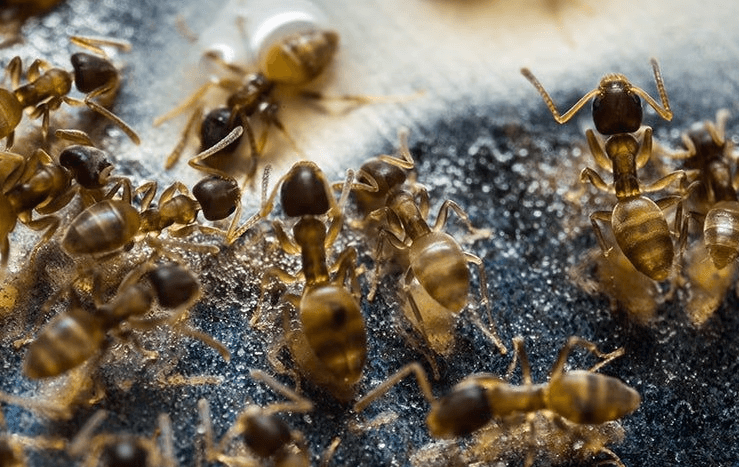
Thief Ant Identification & Prevention In Nassau & Suffolk County, NY
What do thief ants look like?
Latin name: Solenopsis molesta
Size: One of the smallest ants, thief ants measure about 1.5 to 2.2 mm long.
Color: They range in color from yellowish to brown.
Head: Their antennae have 10 segments with a two segmented club
While thief ants and pharaoh ants resemble one another, several characteristics of the thief ant can ensure proper identification.
Thief ants have 10 segmented antennae ending with a two-segmented club.
Pharaoh ants have 12 segmented antennae ending with a three-segmented club.
The thief ant also tends to forage in well-defined trails, while pharaoh ants are less likely to make trails but do so after food or water sources have been established. The thief ant is light brown or yellow in color and measures only 1.5 to 2.2 mm in length.
Thief ants have a waist with two nodes, a thorax without spines and small, compound eyes.

How did I get thief ants?
Thief ants get into the house through cracks in woodwork, holes in walls, and open doors. Once inside, these pests feed on greasy, protein-rich foods and sweets. Homeowners are more likely to see these insects inside searching for food and water during hot weather.
How serious are thief ants?
Because of their very small size, thief ants can get into almost any packaged foods and are difficult to control without help. The pests may live in baseboards and wall crevices as well as outdoors. Thief ants will feed on dead insects and their immature stage larvae and pupae, so there is a possibility of disease organism transmission associated with what thief ants eat.
How do you get rid of thief ants?
All State Pest Control is trained to help manage Field Ants and similar pests. Since every building or home is different, your All State Pest Control technician will design a unique program for your situation.
Keeping ants out of homes and buildings is an ongoing process, not a one-time treatment. All State Pest Control’s exclusive A.I.M. solution is a continuing cycle of three critical steps — Assess, Implement and Monitor.
All State Pest Control can provide the right ant control solution to keep ants in their place…out of your home, or business.

Reasons to Choose All State Pest Control
-
Hablamos EspañolPest control services provided by a Spanish-speaking team.
-
Emergency Services AvailableGet the immediate help you need, whenever you need it.
-
100% Satisfaction GuaranteeWe're so confident you'll be happy with our services, we guarantee it.
-
Offering 100% Free QuotesGet started by giving us a call and setting up a free estimate.
What are the behavior, diet, and habits of thief ants?
Also known as grease ants and sometimes “sugar ants,” thief ants are one of the tiniest household ant species found worldwide. The name is derived from the ants’ habit of stealing larvae and pupae from neighboring colonies.
What do thief ants eat?
Thief ants feed on protein and greasy foods such as nuts, meats, cheese, peanut butter and sweets. Because worker thief ants are small enough to enter food packaging, they can become a nuisance in the kitchen. Outside, thief ants forage for dead insects and rodents. Because of this, it is possible they can transmit pathogens from a food source to human food. Thief also ants feed on immature forms of other ants and insects.

Hear From Our Happy Customers
At All State Pest Control, your satisfaction is our priority! See for yourself what people have to say about working with us.
-
“I highly recommend this business as they are very professional and reasonably priced.”- Stray C.
-
“The job was very thorough, very reasonably priced and Tom was very professional.”- Patrick M.
-
“So happy we used this company and will be using them again! Great work great owner and great service.”- Stefani J.
-
“For bringing them so much work they occasionally offer us free treatments and that is just good business!”- Derek B.
Where do thief ants nest?
Thief ant nests occur in a great variety of locations outside, especially under rocks.
Thief ants nest in rotting wood and soil. They may also nest indoors in small spaces, including wall crevices, cabinet voids, under countertops and behind baseboards. Because thief ants nest in hidden areas, their nests are difficult to locate. The best way to address a thief ant infestation is to contact your local pest control professional, who can identify the species properly and recommend an appropriate treatment.
What is the reproduction and life cycle of thief ants?
Queens lay eggs, which incubate and take 50 days to a few months to fully develop into adults. Thief ant mating swarms appear from June to September, and these reproductive ants may also be seen indoors in the summer. When thief ants enter homes and buildings, they form trails from the food source to their nests. Colonies tend to be smaller than those of other species, but can contain two or more queens and several thousand workers.



